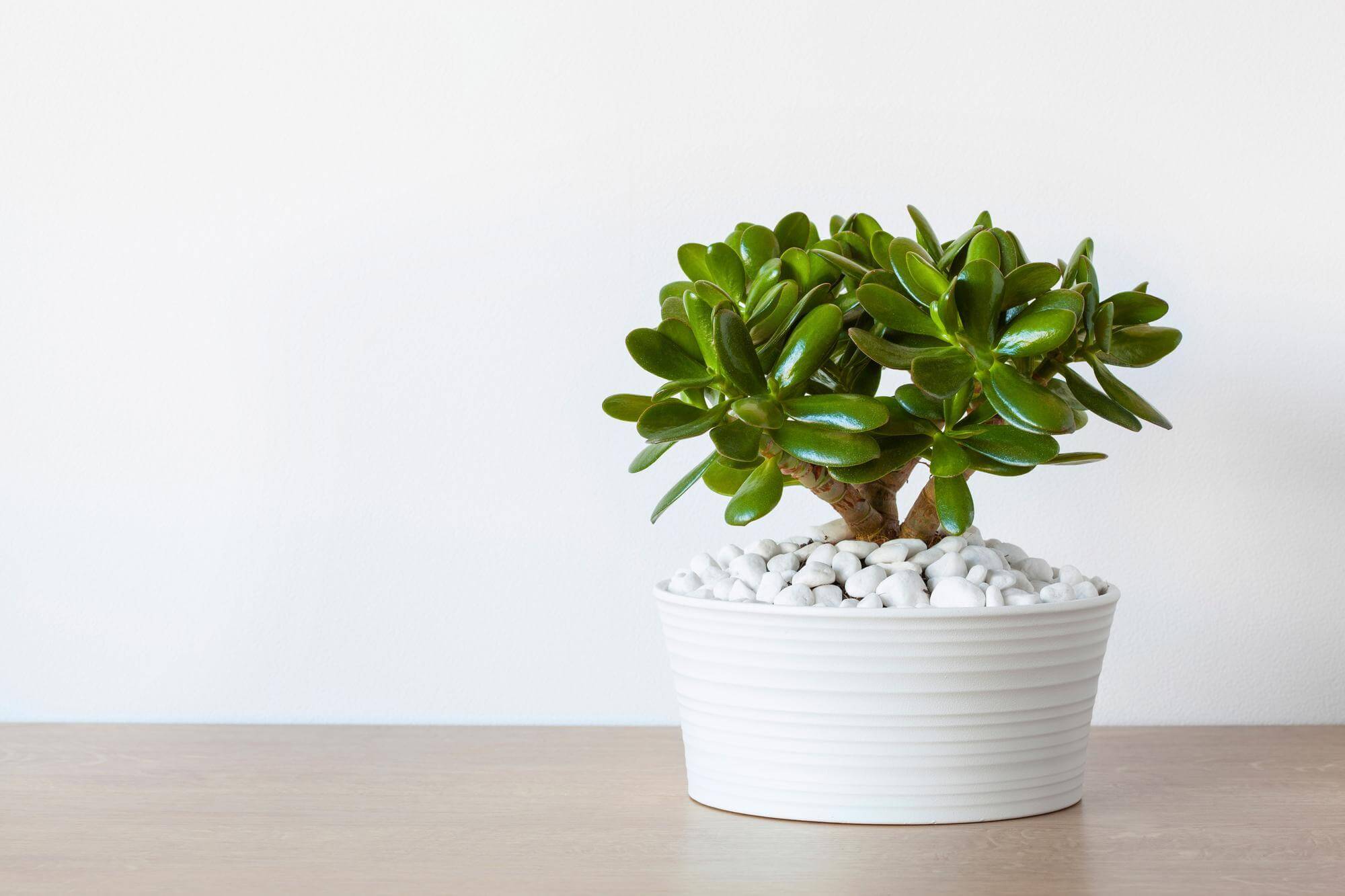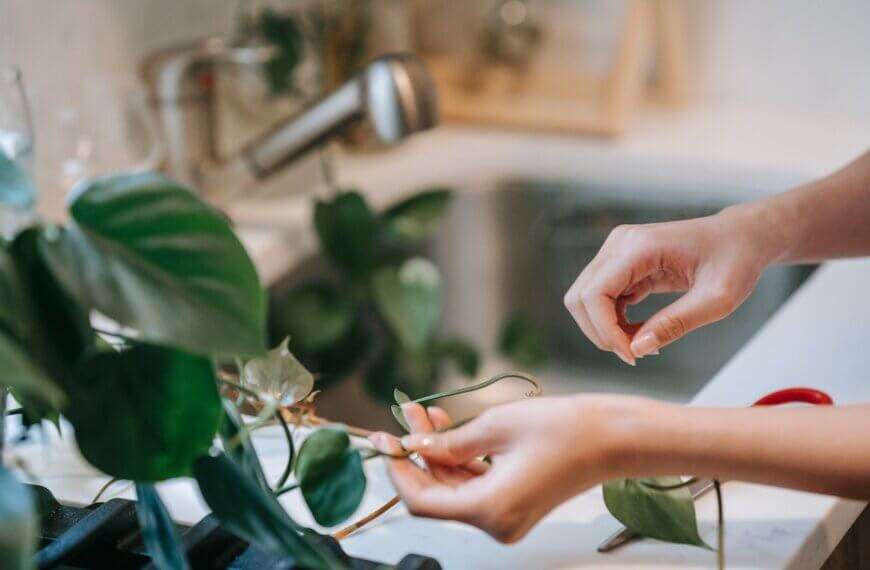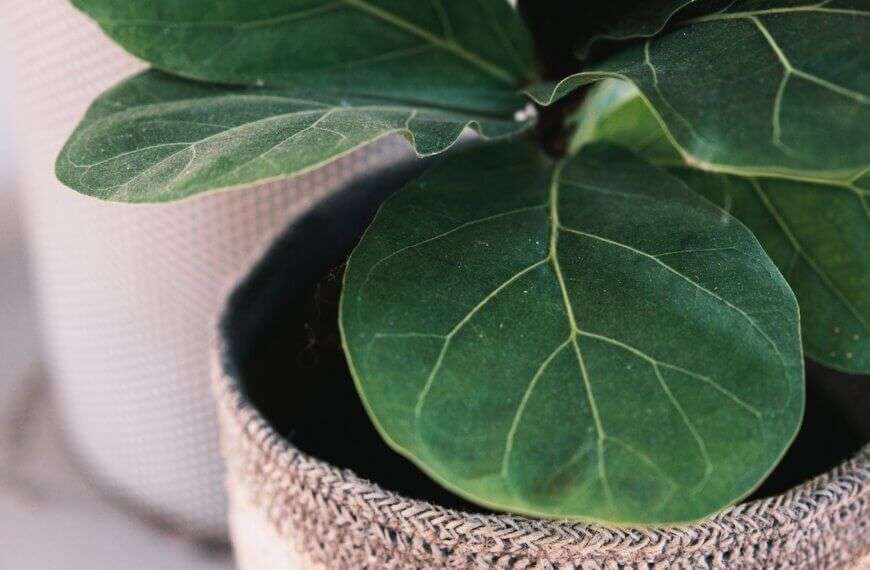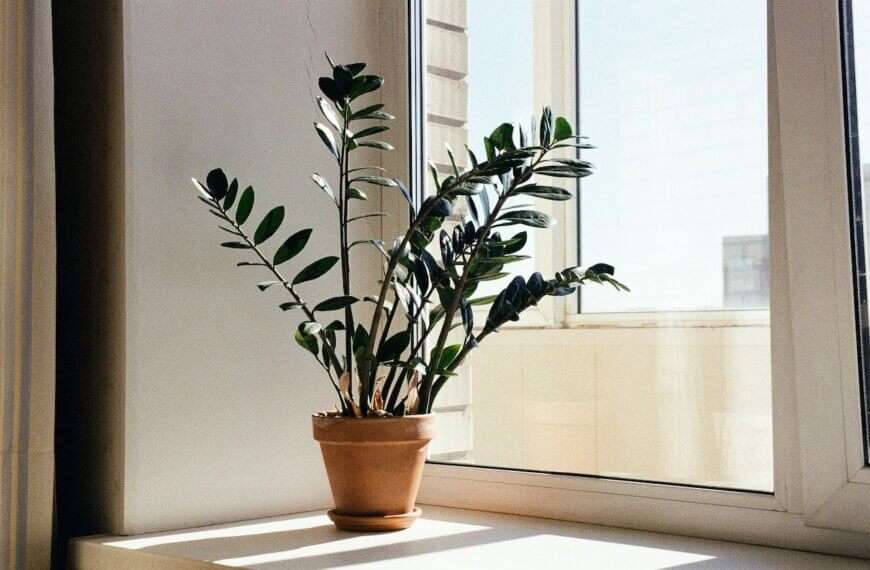Understanding Jade Plants
Jade plants, also known as Crassula Ovata, are succulents which thrive in warm climates. They can reach up to 3 feet tall and boast thick, glossy leaves that store water. Growing them indoors or outdoors is easy if you know their needs.
To care for a jade plant, ensure it gets bright yet indirect sunlight and well-draining soil. Avoid overwatering or leaving them in standing water as this can cause root rot. Preferring temperatures between 65-75 degrees Fahrenheit, they can tolerate low humidity levels.
A notable trait of jade plants is their ability to go dormant during periods of low light or drought. During this time, they may drop some leaves, but will resume growth once conditions improve.
To promote healthy growth, fertilize your jade plant every 6 weeks with a balanced fertilizer for succulents. Pruning the stems and removing yellow leaves can also encourage new growth.
By understanding the needs of your jade plant, you can easily care for it while appreciating its foliage and possible blooms. Remember to be gentle as their leaves are delicate and can break easily. So, think of jade plants as the divas of the succulent world!
Essential Requirements for Jade Plants
To ensure that your jade plant thrives, you must fulfill its essential requirements. This section on “Essential Requirements for Jade Plants” with sub-sections on “Lighting Needs, Temperature and Humidity, Soil Type and pH, Watering Frequency, and Fertilization Schedule” will guide you on how you can fulfill these requirements for the optimal growth and health of your plant.
Lighting Needs
Jade plants need optimal lighting to thrive. Bright, indirect sunlight is best. Place near a window facing east or west. Photosynthesis is how the plant produces food. When it doesn’t get enough light, growth is stunted and leaves turn yellow and fall. Too much light can damage the plant’s tissues. Check leaf color to see if it’s getting enough light. Healthy plants have deep green leaves. Too much sun, leaves have brown spots.
A NASA study found indoor plants like jade absorb toxins from the air and improve air quality. Goldilocks would say jade plants need just the right temperature and humidity for growth. Porridge won’t do!
Temperature and Humidity
Jade Plants: Temperature & Humidity
Jade plants are tolerant of changes in temp & humidity. But, to grow steadily, a consistent environment is essential.
Here’s a table with ideal temp & humidity ranges for jade plants:
| Temperature | Humidity |
|---|---|
| 65-75°F | 40-50% |
Note: extremely high or low temps can harm the plant’s health.
For proper humidity, place a container with water near the plant. But, don’t overwater – it can cause root rot.
And, avoid direct sunlight & cold drafts.
By following these guidelines, you’ll create an environment that’s perfect for your jade plant. Plus, it prefers its soil to be acidic, like its coffee.
Soil Type and pH
For Jade Plants to be well, their soil must be correctly provided for and cared for. Knowing the ‘Soil Type and pH’ is essential as they need a certain soil with a precise pH to be in ideal conditions for growing and developing.
The table below has accurate information on Soil Type and pH needed:
| Soil Type | pH Range |
|---|---|
| Well-draining, light soil mixture | 6.0-7.5 |
Not only must you know the right Soil Type and pH, but also keep an eye on their moisture levels. To avoid waterlogging, pots with drainage holes or mix coarse sand into the soil can help drainage.
Keeping humidity stable is also important to not let the plants dry out. Keep Jade Plants away from air-conditioning or heating vents that might affect humidity.
Gardening Know How experts say, “Jade plants are versatile succulents that thrive indoors with very little maintenance.”
The right soil, plus the right watering frequency, will keep your Jade Plants healthy for years. Watering them is like finding a balance between a thirsty camel and a drowning fish.
Watering Frequency
Watering your jade plant is vital. But, the amount of water they need depends on a few factors. Here are 6 points to keep in mind:
- Make sure the soil is dry before watering again.
- The frequency of watering changes in different climates and seasons.
- Water it evenly and thoroughly.
- Too much water is worse than not enough.
- Jade plants store water inside their leaves, so they need less water.
- Clay pots absorb moisture quickly, so they need more frequent watering.
Also, keep an eye out for any warning signs like brown leaves or wilting.
Lastly, there’s a story of a lady who inherited a jade plant from her grandma. At first, she forgot to water it, so the leaves dropped off. But she reminded herself to water it regularly, and it worked! Jade plants don’t need therapy, but they do need a solid watering plan to stay healthy.
Fertilization Schedule
For optimum growth and development of Jade plants, a fertilization schedule is key. A table should be used to organize it, with columns such as Date, Type, Amount and Method of Application.
For example:
| Date | Type | Amount | Method |
|---|---|---|---|
| March 1 | Balanced NPK | 1 teaspoon per pot | Watering in |
| June 1 | Slow-release | Follow package guides | Dry topdressing |
| September 1 | High-phosphorus | Half strength | Watering in |
Frequency and amount of fertilization should be adjusted depending on factors like plant size, environmental conditions and growth rate.
Organic matter can also be incorporated into the soil to give long-term benefits. This could include compost or mulch near the base of the plant.
In conclusion, a consistent and appropriate fertilization schedule is vital for healthy Jade plants.
Jade Plant Care Techniques
To care for a jade plant successfully, you need to learn some essential techniques. In this part, we’ll discuss Jade Plant Care Techniques, such as Pruning Tips, Propagation Methods, and Pest and Disease Control. These sub-sections will provide you with effective and easy-to-follow solutions to help you keep your Jade plant healthy and thriving.
Pruning Tips
Trim your Jade Plant for growth with these tips!
- Cut off dead foliage with sharp shears.
- Prune back leggy stems to promote bushy growth.
- Pinch out new shoots at their tips.
Don’t over-prune! Too much can stunt growth and create ugly wounds. A gentle pruning every few months works best.
Pro Tip: Prune your Jade Plant in spring or summer when it’s actively growing.
Growing a family of jade plants is a breeze compared to growing a human family. No teenage drama here!
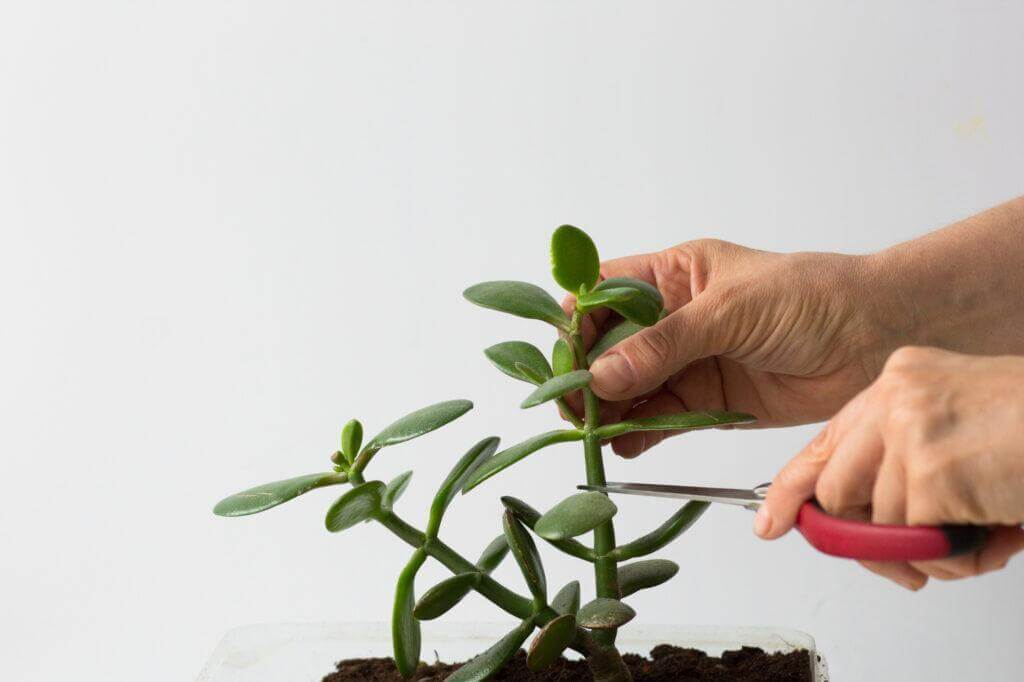
Propagation Methods
Propagating Jade Plants can be done with different methods. A table below shows the methods and their descriptions:
| Propagation Method | Description |
|---|---|
| Stem Cuttings | Cut from a healthy plant and let to dry for days. Then, plant in soil. |
| Leaf Cuttings | Cut from a healthy plant and place in moist soil until new growth appears. |
| Division | Remove from the pot and divide into sections, each with its own roots. |
It is beneficial to use a clean, sharp knife or shovel when dividing to avoid damaging the roots.
A friend of mine did stem cuttings recently and was amazed at how quickly they rooted and grew. They were thrilled to see a new life created by themselves.
Jade plants are still easier to take care of than many family members!
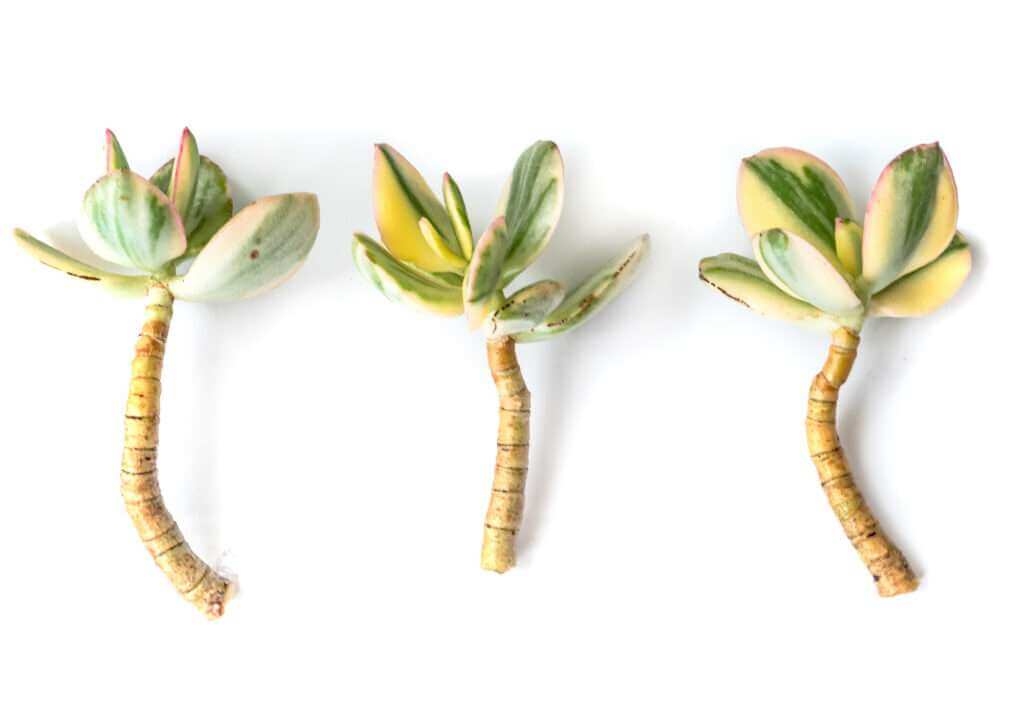
Pest and Disease Control
Protect your Jade Plant’s health and life-span by controlling pests and diseases. Here are some tips! Regular maintenance, proper watering, natural remedies and pruning. Create a healthy environment to ensure your Jade Plant’s growth.
In Chinese gardens centuries ago, the Jade Plant was considered a symbol of wealth. It was said to bring luck and prosperity. Even those without green thumbs can handle the Jade Plant. Little effort needed!
General Maintenance
To care for a jade plant, you’ll need to master the general maintenance. In this section called ‘General Maintenance’ with sub-sections ‘Repotting Guidelines, Winter Care, and Displaying Jade Plants,’ you will learn how to keep your jade plant healthy and beautiful all year long.
Repotting Guidelines
When should you repot your plant? Here are some guidelines to help you:
- Check the roots. If they are growing out of the pot or visible on top, it’s time to repot.
- Choose a larger pot. Make sure it’s no more than 2 inches bigger in diameter than the current pot.
- Prepare the soil. Mix fresh potting soil with compost.
- Gently remove the plant from its pot. Tilt it and tug on its stem.
- Repot! Put some soil mix in the new container. Add the plant, and more soil around it. Pack it down.
- Water it well. Keep an eye for signs of stress.
- Research how often to repot specific plants. Make sure the environment is optimal.
- Don’t neglect this step. Repotting can cause stress, stunting growth & impacting health and longevity.
- Get ready for winter. Sharpen that shovel! ‘Operation Ice-and-Snow Removal’ awaits.
Winter Care
Winter Maintenance for Your Property: Essential!
When winter comes, it’s super important to maintain your home or building. Check all heating systems, seals, and insulation. Make sure pipes aren’t blocked and take preventative measures to reduce corrosion.
Regular checks during the winter months can save you money. Examine your roof, gutters, and ventilation.
Outdoor maintenance matters too. Clear out gutters, shovel snow, and watch out for icy surfaces. Look for any damage, cracks, or irregularities that could be dangerous.
Book contractors before winter to keep maintenance plans up to date. Check pricing and make sure the products are suitable for cold weather.
Displaying Jade Plants
Jade plants are a great way to liven up your indoor space, but they require special care and attention. Here are some tips for showing off these gorgeous succulents to their best advantage.
Positioning: Place near a window with bright, indirect sunlight.
Containers: Go for tall ones or hanging baskets to show off the plant’s height.
Grouping: Grouping them together creates a great visual impact.
Décor Matching: Choose a container that matches your room’s decor.
It’s important to keep in mind that too much direct sunlight can scald the leaves, turning them brown. Plus, avoid overwatering, as the roots can rot.
To get the best results from your Jade plants, select a suitable spot and container size. Remember that they grow slowly and can live for a long time with a little upkeep.
For the best display and health in the long run, we suggest placing your Jade plant in bright yet indirect natural light. Also, pick a container that’s the right size and coordinate with the other décor in the room. Finally, don’t overwater or leave in direct sunlight for too long – following these simple guidelines will give your green friends the perfect environment! Give your Jade plant some TLC and watch it thrive; after all, plants need love too!
Conclusion: How to Ensure the Health and Longevity of Your Jade Plant
Taking care of a Jade Plant is essential for its health and longevity. In order to ensure your jade plant is in good condition, you must take specific steps. These include:
- proper watering
- sufficient light exposure
- temperature control
- humidity regulation
Plus, you should be careful of any possible pest infestations or diseases, and act quickly to treat them.
You should also examine the soil quality and repot when needed, and use proper drainage with an appropriate pot. Additionally, pruning techniques are important in shaping its growth. Use sterilized shears to trim unhealthy branches and leaflets near their base.
Not only physical measures, but knowledge of the history of the plant is also needed to keep it thriving. According to ancient Asian cultures, the jade plant possesses magical properties that can bring prosperity and good luck into your life!
Frequently Asked Questions
Q: How often should I water my jade plant?
A: Jade plants prefer dry conditions and should be watered only when the soil is completely dry, usually every 2-3 weeks.
Q: Can jade plants be placed in direct sunlight?
A: While jade plants thrive in bright light, they should not be placed in direct sunlight as this can cause their leaves to scorch.
Q: What kind of soil is best for jade plants?
A: Jade plants do well in well-draining soil with a slightly alkaline pH. Cactus or succulent soil mixes work well.
Q: How often should I fertilize my jade plant?
A: Fertilize your jade plant once a month during the growing season (spring and summer) with a balanced, water-soluble fertilizer.
Q: How should I prune my jade plant?
A: Prune your jade plant in the spring by removing any dead or damaged leaves. If you want to shape your plant, pinch off the top of each stem to encourage branching.
Q: Can jade plants be propagated?
A: Yes, jade plants can be propagated through leaf or stem cuttings. Allow the cuttings to dry for a few days before planting them in well-draining soil.

